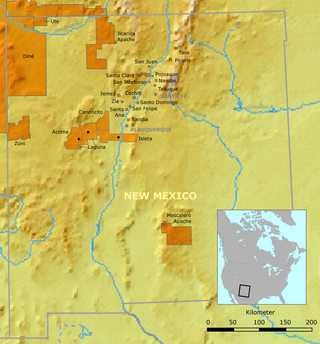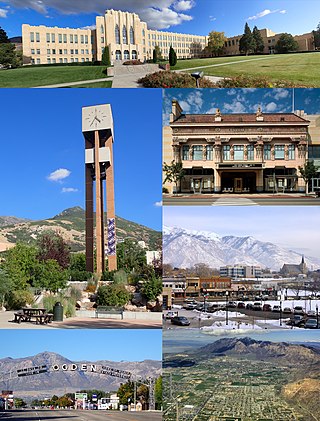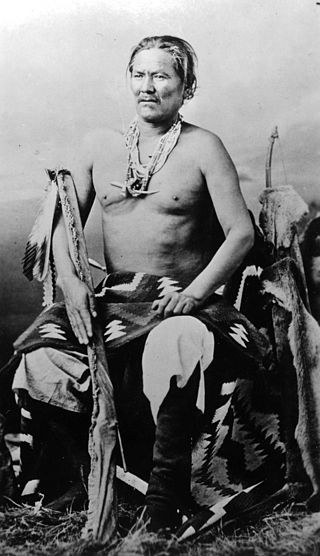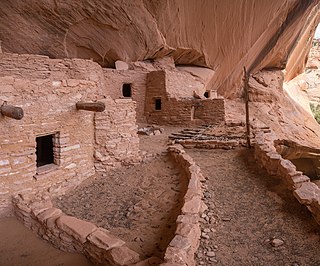
The Denver and Rio Grande Western Railroad, often shortened to Rio Grande, D&RG or D&RGW, formerly the Denver & Rio Grande Railroad, was an American Class I railroad company. The railroad started as a 3 ft narrow-gauge line running south from Denver, Colorado, in 1870. It served mainly as a transcontinental bridge line between Denver and Ogden, Utah. The Rio Grande was also a major origin of coal and mineral traffic.

The Puebloans, or Pueblo peoples, are Native Americans in the Southwestern United States who share common agricultural, material, and religious practices. Among the currently inhabited Pueblos, Taos, San Ildefonso, Acoma, Zuni, and Hopi are some of the most commonly known. Pueblo people speak languages from four different language families, and each Pueblo is further divided culturally by kinship systems and agricultural practices, although all cultivate varieties of corn (maize).

The Hopi are Native Americans who primarily live in northeastern Arizona. The majority are enrolled in the Hopi Tribe of Arizona and live on the Hopi Reservation in northeastern Arizona; however, some Hopi people are enrolled in the Colorado River Indian Tribes of the Colorado River Indian Reservation at the border of Arizona and California.

Ogden is a city in and the county seat of Weber County, Utah, United States, approximately 10 miles (16 km) east of the Great Salt Lake and 40 miles (64 km) north of Salt Lake City. The population was 87,321 in 2020, according to the US Census Bureau, making it Utah's eighth largest city. The city served as a major railway hub through much of its history, and still handles a great deal of freight rail traffic which makes it a convenient location for manufacturing and commerce. Ogden is also known for its many historic buildings, proximity to the Wasatch Mountains, and as the location of Weber State University.

The term Navajo Wars covers at least three distinct periods of conflict in the American West: the Navajo against the Spanish ; the Navajo against the Mexican government ; and the Navajo against the United States. These conflicts ranged from small-scale raiding to large expeditions mounted by governments into territory controlled by the Navajo. The Navajo Wars also encompass the widespread raiding that took place throughout the period; the Navajo raided other tribes and nearby settlements, who in return raided into Navajo territory, creating a cycle of raiding that perpetuated the conflict.

Navajo National Monument is a national monument located within the northwest portion of the Navajo Nation territory in northern Arizona, which was established to preserve three well-preserved cliff dwellings of the Ancestral Puebloan people: Keet Seel, Betatakin, and Inscription House. The monument is high on the Shonto plateau, overlooking the Tsegi Canyon system, west of Kayenta, Arizona. It features a visitor center with a museum, three short self-guided trails, two small primitive campgrounds that are free to the public, and a picnic area.
A union station is a type of railroad station used by more than one railroad company, line, or service provider, typically found in North America.

The Navajo or Diné, are a Native American people of the Southwestern United States.

Gallup station is an Amtrak train station at 201 East Highway 66 in downtown Gallup, New Mexico. It is the second busiest station in the state, with more than 16,000 boardings and alightings in 2014.

Sacred Clowns is a crime novel by American writer Tony Hillerman, the eleventh in the Joe Leaphorn/Jim Chee Navajo Tribal Police series, first published in 1993.

The term Navajo Pueblitos, also known as Dinétah Pueblitos, refers to a class of archaeological sites that are found in the northwestern corner of the American state of New Mexico. The sites generally consist of relatively small stone and timber structures which are believed to have been built by the Navajo people in the late 17th and early 18th centuries.
Albert A. Hale was an American attorney and politician. A member of the Democratic Party, he served in the Arizona Senate from 2004 to 2011 and in the Arizona House of Representatives from 2011 to 2017.

State Route 60 (SR-60) is a 7.496-mile-long (12.064 km) state highway in the U.S. state of Utah, serving local traffic in the Ogden area. It parallels Interstate 84 (I-84) from SR-26 in Riverdale to U.S. Route 89 (US-89) in South Weber, and was part of the first state highway into Weber Canyon.
Camp Navajo was originally opened in 1942 in Bellemont, Arizona. It was originally designated Navajo Ordnance Depot, and its primary use was the storage of ammunition used in the Pacific Theater of World War II. It was renamed Navajo Army Depot in 1965, changed to Navajo Depot Activity in 1982, and then changed in 1993 to its current name. In 1993 the Department of Defense transferred all ammunition activities to Hawthorne Army Ammunition Plant in Nevada. Following the transfer, Camp Navajo remained federal land under the Department of the Army, overseen by the Arizona Army National Guard. The Ordnance Operations and Industrial Park are managed by the Arizona Department of Emergency of Military Affairs (AZDEMA), and the military training mission remains managed by the Arizona Army National Guard. All authority is given through the Department of Defense Army Corps of Engineers regarding engineering, design, and construction management processes for potential DoD and DoD type customers.

Pueblo Depot Activity(PUDA), formerly known as the Pueblo Ordnance Depot and the Pueblo Army Depot, was a U.S. Army ammunition storage and supply facility. Responsibility for the depot fell upon the United States Army Ordnance Corps, and the first civilians were hired in 1942 as operations began. The mission quickly expanded to include general supplies as well. It is a 24,202-acre (97.94 km2) site located 14 miles (23 km) east of Pueblo, Colorado at 38°19′37.07″N104°20′22.4″W. In 1945 they began to receive mass amounts of equipment returning from the combat theaters of World War II. Therefore, the mission expanded yet again to include the maintenance and refurbishing of artillery, fire control, and optical material. In 1951 the depot assumed responsibility to distribute U.S. Air Force ammunition for an eight-state area, as well as storage of strategic and critical materials for the General Services Administration (GSA). They were also tasked to rebuild and provide on-site maintenance support for guided missiles, ensure calibration and maintenance of electronic test equipment and radio-controlled aerial targets. They would also provide specialized training for new Army equipment as needed. In 1952, Rocky Mountain Arsenal in Denver, Colorado transferred chemical agents and chemical munitions to Pueblo Army Depot for secure storage. In 1974 Pueblo Army Depot was redesignated as Pueblo Depot Activity.

The Ancestral Puebloans, also known as the Anasazi and by the earlier term the Basketmaker-Pueblo culture, were an ancient Native American culture that spanned the present-day Four Corners region of the United States, comprising southeastern Utah, northeastern Arizona, northwestern New Mexico, and southwestern Colorado. They are believed to have developed, at least in part, from the Oshara tradition, which developed from the Picosa culture. The people and their archaeological culture are often referred to as Anasazi, a term introduced by Alfred V. Kidder from the Navajo word anaasází meaning 'enemy ancestors' although Kidder thought it meant 'old people'. Contemporary Puebloans object to the use of this term, with some viewing it as derogatory.












